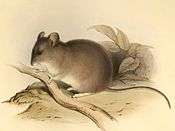Yellow-rumped leaf-eared mouse
| Yellow-rumped leaf-eared mouse | |
|---|---|
| Scientific classification | |
| Kingdom: | Animalia |
| Phylum: | Chordata |
| Class: | Mammalia |
| Order: | Rodentia |
| Family: | Cricetidae |
| Subfamily: | Sigmodontinae |
| Tribe: | Phyllotini |
| Genus: | Phyllotis |
| Species: | P. xanthopygus |
| Binomial name | |
| Phyllotis xanthopygus (Waterhouse, 1837) | |
The yellow-rumped leaf-eared mouse (Phyllotis xanthopygus) otherwise known as the Patagonian leaf-eared mouse is a species of rodent in the family Cricetidae and order Rodentia. It is the most widespread member of the genus.
Description
Phyllotis xanthopygus is a predominantly greyish brown/sand-colored New World mouse that reaches around 55g in its adulthood[1] (relatively large for its genus). Its thick coat is typically lighter on its underside, most prominent posteriorly, exhibiting countershading that is typical for many small mammals as it aids in camouflage from predators.[1] True to its name, the Patagonian leaf-eared mouse has broad triangular ears similar to other leaf-eared members that compose the genus Phyllotis.

The pelage of Phyllotis xanthopygus is known to differ seasonally.[1] This example of phenotypic plasticity contributes to its ability to camouflage in a dynamic, seasonal, environment. Blending in with the vegetation and rocky outcrops is an important characteristic as their primary predators are raptors[2] most notably owls, which rely on being able to spot their prey from the air. While not explicitly nocturnal, they are most active at night due to the correlation between light intensity, visibility, and predation risk.[2]
Distribution and Habitat
Phyllotis xanthopygus occurs in South America, specifically against the Andes Mountain and in Peru, Argentina, Chile, and Bolivia from sea level to 5,000 m.[2] While the rocky habitat of the Andes provides ample cover from predators, the high elevation environments are limiting in food availability therefore restricting reproduction to the warmer months.[3]
Its distribution at high altitudes across the Andean plateau[4] has led to plasticity in its non-shivering thermogenosis in order to cope with the low temperatures. This thermal acclimation relies on brown adipose tissue and is often induced by ingestion.[4] This adaptation is important for small mammals like Phyllotis xanthopygus that undergo torpor because it accelerates heating during arousal events.
There is insufficient research concerning small mammalian populations south of Mendoza Argentina[5] due to the large array of species within Rodentia as well as the continuous discovery of new members.
Diet
Members of Cricetidae are known for variety in their diets, for Phyllotis xanthopygus this range includes herbivory, insectivory, granivory, and frugivory. This variation enables them to be opportunistic feeder:[3] an advantageous trait as it permits quick and unselective foraging in open and vulnerable areas.[2]
Their teeth are specialized to accommodate for the diversity in their diet as they have enlarged incisors which are separated from the cheekteeth by a diastema. The teeth are characterized as aradicular, being that they grow continuously throughout an organism's' lifetime. This results in the incisors resembling a chisel due to rapid wear on the soft dentin at the back of the tooth from rubbing against one another.
References
- 1 2 3 Kramer, K. Monjeau, A. Birney, E. Sikes, R. (1999). "Phyllotis xanthopygus". Mammalian Species. 617: 1–7.
- 1 2 3 4 Kramer, K. Birney, E. "Effects of Light Intensity on Activity Patterns of Patagonian Leaf-Eared Mice, Phyllotis xanthopygus". Journal of Mammalogy. 82 (2): 534–544 – via JSTOR.
- 1 2 López-Cortés, F. Cortés, A. Miranda, E. Rau, J. (2007). "Feeding habits of Abrothrix andinus, Phyllotis xanthopygus (Rodentia) and Lepus europaeus (Lagomorpha) in an Andean environment of Chile". Revista Chilena de Historia Natural. 80: 3–12.
- 1 2 Nespolo, R. Opazo,J. Rosenmann, M. Bozinovic, F. (1999). "Thermal acclimation, maximum metabolic rate, and nonshivering thermogenesis of Phyllotis xanthopygus (Rodentia) in the Andes mountains". Journal of Mammalogy. 80 (3): 742–748. doi:10.2307/1383243.
- ↑ Pardińas, U.F.J. Teta, P. Sauthier, D.U. (2008). "Mammalia, Didelphimorphia and Rodentia, Southwest of the province of Mendoza, Argentina". Check List. 4: 218–225. doi:10.15560/4.3.218.
- Baillie, J. 1996. Phyllotis xanthopygus. 2006 IUCN Red List of Threatened Species. Downloaded on 9 July 2007.
- Musser, G. G. and M. D. Carleton. 2005. Superfamily Muroidea. pp. 894–1531 in Mammal Species of the World a Taxonomic and Geographic Reference. D. E. Wilson and D. M. Reeder eds. Johns Hopkins University Press, Baltimore.
- Steppan, S. J. 1996. Phyllotis xanthopygus. Tree of Life. Downloaded on August 17, 2010.
